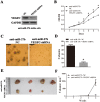miRNA-27b targets vascular endothelial growth factor C to inhibit tumor progression and angiogenesis in colorectal cancer
- PMID: 23593282
- PMCID: PMC3625233
- DOI: 10.1371/journal.pone.0060687
miRNA-27b targets vascular endothelial growth factor C to inhibit tumor progression and angiogenesis in colorectal cancer
Abstract
Colorectal cancer (CRC) is one of the most prevalent cancers globally and is one of the leading causes of cancer-related deaths due to therapy resistance and metastasis. Understanding the mechanism underlying colorectal carcinogenesis is essential for the diagnosis and treatment of CRC. microRNAs (miRNAs) can act as either oncogenes or tumor suppressors in many cancers. A tumor suppressor role for miR-27b has recently been reported in neuroblastoma, while no information about miR-27b in CRC is available. In this study, we demonstrated that miR-27b expression is decreased in most CRC tissues and determined that overexpression of miR-27b represses CRC cell proliferation, colony formation and tumor growth in vitro and in vivo. We identified vascular endothelial growth factor C (VEGFC) as a novel target gene of miR-27b and determined that miR-27b functioned as an inhibitor of tumor progression and angiogenesis through targeting VEGFC in CRC. We further determined that DNA hypermethylation of miR-27b CpG islands decreases miR-27b expression. In summary, an anti-tumor role for miR-27b and its novel target VEGFC in vivo could lead to tumor necrosis and provide a rationale for developing miR-27b as a therapeutic agent.
Conflict of interest statement
Figures






Similar articles
-
MiR-590-5p inhibits colorectal cancer angiogenesis and metastasis by regulating nuclear factor 90/vascular endothelial growth factor A axis.Cell Death Dis. 2016 Oct 13;7(10):e2413. doi: 10.1038/cddis.2016.306. Cell Death Dis. 2016. PMID: 27735951 Free PMC article.
-
MicroRNA-27b, microRNA-101 and microRNA-128 inhibit angiogenesis by down-regulating vascular endothelial growth factor C expression in gastric cancers.Oncotarget. 2015 Nov 10;6(35):37458-70. doi: 10.18632/oncotarget.6059. Oncotarget. 2015. PMID: 26460960 Free PMC article.
-
miR-23a-3p is a Key Regulator of IL-17C-Induced Tumor Angiogenesis in Colorectal Cancer.Cells. 2020 Jun 1;9(6):1363. doi: 10.3390/cells9061363. Cells. 2020. PMID: 32492770 Free PMC article.
-
Molecular functions of microRNAs in colorectal cancer: recent roles in proliferation, angiogenesis, apoptosis, and chemoresistance.Naunyn Schmiedebergs Arch Pharmacol. 2024 Aug;397(8):5617-5630. doi: 10.1007/s00210-024-03076-w. Epub 2024 Apr 15. Naunyn Schmiedebergs Arch Pharmacol. 2024. PMID: 38619588 Review.
-
Promising therapeutic role of miR-27b in tumor.Tumour Biol. 2017 Mar;39(3):1010428317691657. doi: 10.1177/1010428317691657. Tumour Biol. 2017. PMID: 28351320 Review.
Cited by
-
High expression of cAMP-responsive element-binding protein 1 (CREB1) is associated with metastasis, tumor stage and poor outcome in gastric cancer.Oncotarget. 2015 Apr 30;6(12):10646-57. doi: 10.18632/oncotarget.3392. Oncotarget. 2015. PMID: 25825983 Free PMC article.
-
Leptin promotes VEGF-C production and induces lymphangiogenesis by suppressing miR-27b in human chondrosarcoma cells.Sci Rep. 2016 Jun 27;6:28647. doi: 10.1038/srep28647. Sci Rep. 2016. PMID: 27345723 Free PMC article.
-
Decreased miR-154 expression and its clinical significance in human colorectal cancer.World J Surg Oncol. 2015 Jun 6;13:195. doi: 10.1186/s12957-015-0607-5. World J Surg Oncol. 2015. Retraction in: World J Surg Oncol. 2019 Jun 14;17(1):105. doi: 10.1186/s12957-019-1647-z. PMID: 26048406 Free PMC article. Retracted.
-
Interactome of miRNAs and transcriptome of human umbilical cord endothelial cells exposed to short-term simulated microgravity.NPJ Microgravity. 2020 Jul 30;6:18. doi: 10.1038/s41526-020-00108-6. eCollection 2020. NPJ Microgravity. 2020. PMID: 32821776 Free PMC article.
-
TP73-AS1 promotes gastric cancer proliferation and invasion by regulation miR-27b-3p/TMED5 axis.J Cancer. 2022 Feb 7;13(4):1324-1335. doi: 10.7150/jca.66683. eCollection 2022. J Cancer. 2022. PMID: 35281863 Free PMC article.
References
-
- Ferlay J, Shin HR, Bray F, Forman D, Mathers C, et al. (2010) Estimates of worldwide burden of cancer in 2008: GLOBOCAN 2008. Int J Cancer 127: 2893–2917. - PubMed
-
- Vo DM, Julien LA, Thorson AG (2010) Current controversies in colon and rectal cancer. Minerva Chir 65: 677–693. - PubMed
-
- Greenlee RT, Hill-Harmon MB, Murray T, Thun M (2001) Cancer statistics, 2001. CA Cancer J Clin 51: 15–36. - PubMed
-
- Mueller MM, Fusenig NE (2004) Friends or foes - bipolar effects of the tumour stroma in cancer. Nature Reviews Cancer 4: 839–849. - PubMed
-
- Balkwill F (2004) Cancer and the chemokine network. Nature Reviews Cancer 4: 540–550. - PubMed
Publication types
MeSH terms
Substances
LinkOut - more resources
Full Text Sources
Other Literature Sources
Medical

